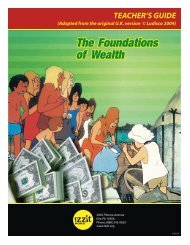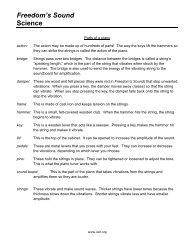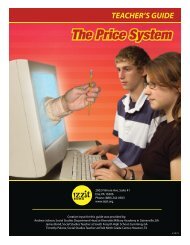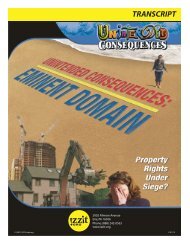Unstoppable Solar Cycles Transcript - Izzit.org
Unstoppable Solar Cycles Transcript - Izzit.org
Unstoppable Solar Cycles Transcript - Izzit.org
You also want an ePaper? Increase the reach of your titles
YUMPU automatically turns print PDFs into web optimized ePapers that Google loves.
TRANSCRIPT2002 Filmore AvenueErie, PA 16506Phone: (888) 242-0563www.izzit.<strong>org</strong>© 2008, 2013 izzit.<strong>org</strong>V. 01/13
<strong>Unstoppable</strong> <strong>Solar</strong> <strong>Cycles</strong><strong>Transcript</strong>For a list of additional resources to use with this video go towww.izzit.<strong>org</strong>/products and click on the <strong>Unstoppable</strong> <strong>Solar</strong> <strong>Cycles</strong> video.BETH: The sun, a soda and a scientific mystery.As a student we learn to ask questions about everything. Today an important question is, “What’s reallycausing global warming?” We’re told it’s CO 2 but I was surprised to learn it could be something else.We certainly need to find out the truth. Some of my friends think the debate is over. Now I’m not sure.Taken together the Great Lakes are the largest body of fresh water in the world with a huge watershed.The water level is down right now but in the 1980s and 90s there was concern about high water and shoreerosion.Weather changes constantly – day to day, month to month and in yearly cycles. Scientists tell us theclimate, like weather, changes in repeating cycles. Sometimes these changes create big problems forpeople living on planet Earth.It is an amazing world of stark and dramatic beauty. Giant ice floes seem to rise up from the ocean tostand guard over the mountains and fiords where most of its inhabitants live. We are in Greenland, theworld’s largest island isolated between the North Atlantic and Arctic oceans.The Norwegian Erik the Red came here in the 10th century. He named it “Greenland” and his followerssettled here. For centuries they called it home.RIE OLDENBURG: They came here, as the saga says, around the year 985 and they found greenvalleys - valleys with a little growth of trees up to 3 or 4 meters high, a lot of grazing land - a beautifulcountryside for a farmer.INGIBJORG GILSLADOTTIR: Back then, it was warmer, there were more trees. It was very goodfarming land, very fertile and very green.OLDENBURG: Rumors of this wonderful land must have spread so you had more inhabitants. We thinkof this as a rough life but they have had fashionable clothing and they have had time to play. It’s beentough but they have had good times as well.BETH: By 1100 the Viking communities in Greenland were vibrant and thriving. Then, within just a fewhundred years, they were wiped out because the climate had changed.GILSLADOTTIR: The climate changed, that’s a fact, everybody knows that. So it was getting veryhard to be a farmer and, well, they didn’t get enough hay for the animals and the animals were freezingand starving so the animals died. And when the animals die, the people die.1
OLDENBURG: Around the year 1350, a representative of the Bishop Regatta visited the westernsettlement and he wrote home and told that “there’s no one here.”BETH: In just three hundred years Greenland had grown so cold that all the Vikings who lived there f<strong>org</strong>enerations were completely gone.Meet Dr. Willie Soon. He’s a scientist who studies climate.DR. WILLIE SOON: They must have wondered, “What happened to our climate system? Did we dosomething to cause this?” It would be really, really useful to learn from the Vikings’ example how do wego about coping with big natural changes in the Sun and the Earth’s climate system?BETH: So, how can humans cope with natural changes in the climate system? Scientists study the pastto help them understand what’s causing similar changes today and they’re finding natural cycles thatmove between periods of warm and cold.They’ve learned about these cycles by using a variety of techniques – ice cores, sediment cores and treerings and they’ve identified a likely cause.Meet Dr. David Legates.DR. DAVID LEGATES: Climate is not a constant. We go through periods where it's much warmer,where it's much colder. We go through periods where it's wetter and drier. So the one thing we can sayabout climate in the future is that it will change.BETH: As the Vikings’ green land turned to snow and ice other parts of the world were cooling down,too. In England the River Thames began to freeze over. So did canals and waterways in the Netherlands.The Earth’s climate was entering what scientists now call “The Little Ice Age.”SOON: Conditions were quite severe. In Western Europe you can see people were actually praying in thechurch while the glacier is advancing, essentially are praying that, “Please, God, don’t let this ice come inand ruin our village.”BETH: The Little Ice Age is part of a series of climate-change eras that have been scientificallyidentified. In Europe there was a warming period at the height of the Roman Empire followed by acooling during the Dark Ages. The climate warmed again during medieval times followed by “The LittleIce Age” during the Renaissance.LEGATES: The Little Ice Age ended at about 1850. So over the past 150 or so years we have been in acycle where the earth has generally been warming.BETH: And this current climate cycle is what most people call “global warming.”LEGATES: The sun is the key ingredient to climate. I mean, 99.9 percent of the energy on the earth thatgoes into the climate system comes from the sun.2
SOON: The sun, of course, in terms of its light energy output is probably the only true external driver ofthe Earth climate system because there are no other forces on Earth that would supply that amount ofenergy for the air to move around, the ocean currents to move around or trees to grow. So there is nodoubt that the sun is the main driver and supplier of energy to the Earth’s weather and climate system.BETH: So, the sun’s magnetic fields experience regular, natural cycles and scientists have found thatwhen sunspot activity changes temperatures on earth change. Variations in radiation from the sun wouldlogically contribute to variations in temperature and climate on earth. Dr. Soon says this is importantwhen we’re trying to understand climate patterns. One thing is certain - the sun’s natural cycles are aprimary driver of natural climate cycles here on earth.SOON: You have such a strong indication that there is this close relationship between how much theenergy output from the sun changes, and then how much the temperature changes.BETH: What about the role that carbon dioxide, or CO 2 , plays in the earth’s climate? Is the warmingbeing caused by human-generated carbon dioxide, is it the sun or is it a combination of these and otherthings?LEGATES: Humans do affect our environment and one of the ways they do that is to change theconstituents in the atmosphere. I think the biggest driver is going to be other natural fluctuations andcarbon dioxide plays a small role in that.BETH: The modern warming of Greenland has been going on since 1850 - long before human-generatedCO 2 was increasing.In general, there’s a consistent warming pattern. The best available records of temperature andatmospheric CO 2 over the past 650,000 years indicate that the earth’s temperature always rises FIRST,followed by a rise in carbon dioxide.SOON: Published papers clearly, clearly show that it is always the temperature rises first by at leastseveral hundred years to a few thousand years. And then the carbon dioxide curve responds and itfollows. So it is a very clear scientific consensus on this issue.BETH: If a warmer earth leads to increased levels of CO 2 … and not the other way around, then canhumans use of fossil fuel be the cause of global warming?SOON: Most of us still have that nagging question in us. “Yes, we have emitted all this carbon dioxide.Are we really, really melting all the icecaps or is it something even more powerful than that?” I mean,meaning that, could it be even the sun actually that is doing it?BETH: Some scientists think the world’s oceans may play a key role in all of this. They contain largeamounts of carbon dioxide which, when the sun heats them up, is released into the atmosphere.We see the same effect when we have a can of soda. As we’ve learned, the bubbles in soda are carbondioxide – CO 2 . As you hold the can it warms up and gives off bubbles of carbon dioxide. Leave anunopened can sitting on a picnic table and when you open it- you get a dramatic idea of the impact of thesun.3
SOON: If you started to warm the surface ocean temperature, the ability for the ocean water to hold thiscarbon dioxide in the system is a lot less, meaning there would be more of this carbon dioxide effusingout.BETH: Scientists are also looking at the icecap on Mars. It’s been shrinking like the Earth’s polaricecaps are shrinking. Mars isn’t affected by the CO 2 we create to make i-Pods or grow more food … butit is affected by the sun’s radiation.SOON: You clearly see drastic warming and melting of the icecap. There is no doubt that somethingnatural is occurring that has caused the icecap to melt away on Mars, and the forces could not be humanemission of carbon dioxide.LEGATES: The one thing I've learned over about 30 years of study of the climate has been it's a verycomplicated system. We like to simplify it for discussion with students, with laypersons, but it's really avery complicated system.BETH: This is the challenge. Do we really understand what’s happening? We are urged to accept justone theory --- that human-generated CO 2 is the principal cause of global warming. Yet these and otherscientists point to other possible causes.The journal Physics and Society, which is a publication of The American Physical Society with amembership of over 50,000 physicists, now welcomes debate of the question.Scientists are also expressing concern about the distortion of the science.SOON: Those views are indeed promoted by political bodies which is the Intergovernmental Panel forClimate Change. And there appears to be a corrupted process, in my opinion, of the bodies.LEGATES: There’s a science document which is really written by scientists, for scientists. There’s alsoa summary for policymakers. It’s put together by policymakers and in many cases they go back to thescientists and say, “Can you change the science document to match our summary? We want to beef thisup. We want to make it look worse.” That’s not the way science is done.SOON: I think science and scientists are being misused in a lot of ways. And these are all becomingreally the war of words instead of war of evidence and science. That troubles me.LEGATES: So the idea of science is you're really supposed to be skeptical. So there's always a quest toverify what we know, to understand that we haven't made a mistake and that we continue on and developscience. If we've closed our minds - if we close the doors - we are now shutting ourselves out from thereal truth which is what science is all about after all.BETH: Does this trouble you? Why would these scientists be told not to question human-created CO 2 asa cause of global warming? What if human activities aren’t causing global warming?SOON: There is no one in the world who would insist that everything is having to do with the sun. Allwe are trying to do is… that there is this plausible picture of how the sun could cause some of the changesin the climate system, and why not study it carefully?4
It’s very, very difficult, in my opinion, to try to insist and suggest that carbon dioxide, even as of todaywhen we emit this carbon dioxide, is going to drive the climate system. This is a complete false pictureand there is no such scientific basis to support that.BETH: I’m not a scientist. I’m a student like you, but everyone knows that what science says is truechanges with each new research project, and with every new piece of evidence. Even research as recentas last year is frequently incomplete or inaccurate.From what I’ve heard the cost to reduce CO 2 will be enormous and, as the scientists said, this may not bethe cause. We could create disaster for poor countries and hardship for all of us and not change thepattern of warming and cooling.We need to encourage scientists to consider every possibility. We need to get this right. Don’t you agree?For a list of additional resources to use with this video go towww.izzit.<strong>org</strong>/products and click on the <strong>Unstoppable</strong> <strong>Solar</strong> <strong>Cycles</strong> video.5
We are very interested to learnhow you use our material. Pleaseshare your experiences or lessonplan ideas by visiting usat www.izzit.<strong>org</strong>.2002 Filmore AvenueErie, PA 16506Phone: (888) 242-0563www.izzit.<strong>org</strong>
















